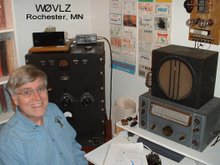 Since getting a 3S4 QRP midget transmitter I've been thinking about building a receiver to match it. I wanted to use tubes along the same lines as the 3S4 and, at the same time, have a late 50s style. The late 50s/early 60s ARRL "How to Become a Radio Amateur" featured a two tube regen with a 3 1/2" National type K dial. That sort of style was what I was looking for.
Since getting a 3S4 QRP midget transmitter I've been thinking about building a receiver to match it. I wanted to use tubes along the same lines as the 3S4 and, at the same time, have a late 50s style. The late 50s/early 60s ARRL "How to Become a Radio Amateur" featured a two tube regen with a 3 1/2" National type K dial. That sort of style was what I was looking for. I've found the parts I need and have played with them to figure out a layout I like. The chassis is marked up and I'm ready to drill.
I've found the parts I need and have played with them to figure out a layout I like. The chassis is marked up and I'm ready to drill.| Parts List (use 1/2 watt resistors): | R1 1 Meg R2 39K R3 100 K Potentiometer R4 47K R5 2 Meg Potentiometer R6 47K C1 11-194 pF Variable (7 full plates) C2 9-19 pF Variable (one ¾ inch diam. plate) C3 100 pF C4 .002 uF C5 .01 uF |
C6, C9 1 uF @ 100V C7 .05 uF C8 .22 uF L1,2,3 Wound on same PVC form T1 10K to 8 ohm Audio Transformer |


